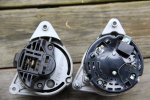 Lost the input shaft nut on the alternator, ruined the alt fan and pulley. It seems all the rebuilt unit do not come with the pulley and fan. Found a new on Rock Auto. It arrived yesterday an looks very good and quite similar to the old one. Similar, but not exact. Different mount spacing and wiring is different. Different connectors (mostly size) and connector labels. I think I can fake the physical adaption and can attach any wire to any electrical terminal, except I don't have a clue which wire should go where, My only clue is the new alternator is internally regulated.
Lost the input shaft nut on the alternator, ruined the alt fan and pulley. It seems all the rebuilt unit do not come with the pulley and fan. Found a new on Rock Auto. It arrived yesterday an looks very good and quite similar to the old one. Similar, but not exact. Different mount spacing and wiring is different. Different connectors (mostly size) and connector labels. I think I can fake the physical adaption and can attach any wire to any electrical terminal, except I don't have a clue which wire should go where, My only clue is the new alternator is internally regulated. The terminals are identified as:
Old alternator
+
-
F-
IND
Appears to be wired into a Lucas component labelled "4TR Alternator Control"
New Alternator
B+
Blank
WL
WL
And W, this is located next to an opening with no terminal present
I suppose the "+" wire should go on the B+ terminal. And the IND wire is the dash light and stimulator, but where should it attach?
photos attached.
